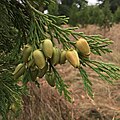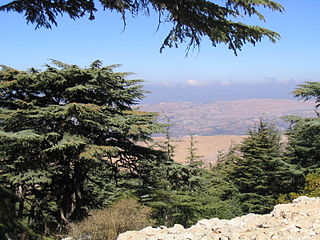
Cedrus, with the common English name cedar, is a genus of coniferous trees in the plant family Pinaceae. They are native to the mountains of the western Himalayas and the Mediterranean region, occurring at altitudes of 1,500–3,200 m in the Himalayas and 1,000–2,200 m in the Mediterranean.
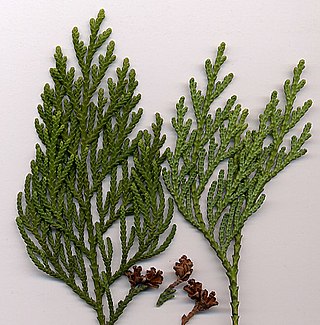
Thuja is a genus of coniferous tree or shrub in the Cupressaceae. There are five species in the genus, two native to North America and three native to eastern Asia. The genus is monophyletic and sister to Thujopsis. Members are commonly known as arborvitaes, thujas or cedars.
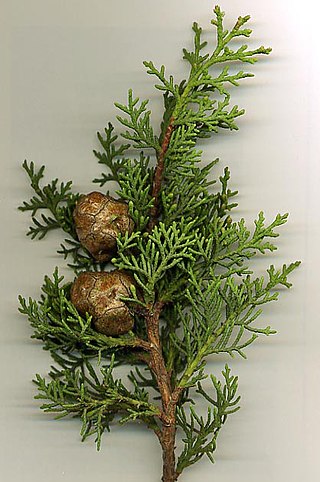
Cupressaceae is a conifer family, the cypress, with worldwide distribution. The family includes 27–30 genera, which include the junipers and redwoods, with about 130–140 species in total. They are monoecious, subdioecious or (rarely) dioecious trees and shrubs up to 116 m (381 ft) tall. The bark of mature trees is commonly orange- to red-brown and of stringy texture, often flaking or peeling in vertical strips, but smooth, scaly or hard and square-cracked in some species.
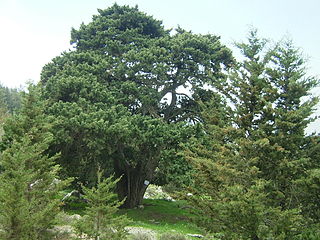
Cupressus is one of several genera of evergreen conifers within the family Cupressaceae that have the common name cypress; for the others, see cypress. It is considered a polyphyletic group. Based on genetic and morphological analysis, the genus Cupressus is found in the subfamily Cupressoideae. The common name "cypress" comes via the Old French cipres from the Latin cyparissus, which is the latinisation of the Greek κυπάρισσος (kypárissos).
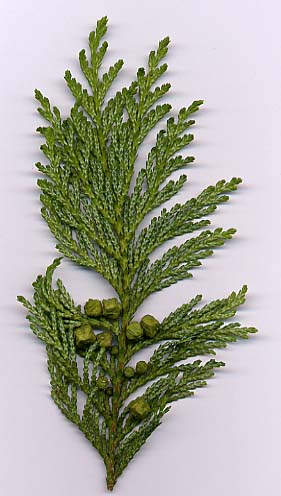
Chamaecyparis, common names cypress or false cypress, is a genus of conifers in the cypress family Cupressaceae, native to eastern Asia and to the western and eastern margins of the United States. The name is derived from the Greek khamai (χαμαί), meaning "on the earth", and kuparissos (κυπάρισσος) for "cypress".

Tsuga is a genus of conifers in the subfamily Abietoideae of Pinaceae, the pine family. The common name hemlock is derived from a perceived similarity in the smell of its crushed foliage to that of the unrelated plant poison hemlock. Unlike the latter, Tsuga species are not poisonous.

Callitropsis nootkatensis, formerly known as Cupressus nootkatensis, is a species of tree in the cypress family native to the coastal regions of northwestern North America. This species goes by many common names including: Nootka cypress, yellow cypress, Alaska cypress, Nootka cedar, yellow cedar, Alaska cedar, and Alaska yellow cedar. The specific epithet nootkatensis is derived from its discovery by Europeans on the lands of a First Nation of Canada, the Nuu-chah-nulth people of Vancouver Island, British Columbia, who were formerly referred to as the Nootka.

Platycladus is a monotypic genus of evergreen coniferous trees in the cypress family Cupressaceae, containing only one species, Platycladus orientalis, also known as Chinese thuja, Oriental arborvitae, Chinese arborvitae, biota or Oriental thuja. It is native to northeastern parts of East Asia and North Asia, but is also now naturalised as an introduced species in other regions of the Asian continent.

Afrocarpus is a genus of conifers of the family Podocarpaceae. Two to six species are recognized. They are evergreen trees native to Africa. Afrocarpus was designated a genus in 1989, when several species formerly classified in Podocarpus and Nageia were reclassified.
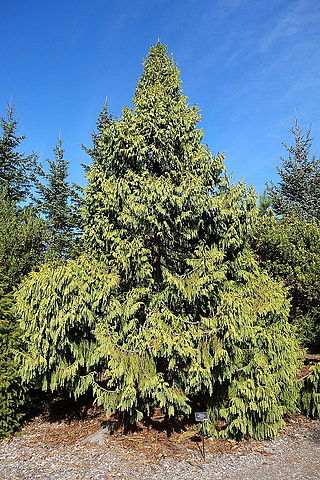
Taiwania, with the single living species Taiwania cryptomerioides, is a large coniferous tree in the cypress family Cupressaceae.
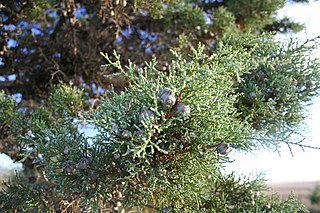
Actinostrobus is a genus of coniferous trees in the Cupressaceae. Common names include cypress, sandplain-cypress and cypress-pine, the last of these shared by the closely related genus Callitris.

Libocedrus is a genus of five species of coniferous trees in the cypress family Cupressaceae, native to New Zealand and New Caledonia. The genus is closely related to the South American genera Pilgerodendron and Austrocedrus, and the New Guinean genus Papuacedrus, both of which are included within Libocedrus by some botanists. These genera are rather similar to the Northern Hemisphere genera Calocedrus and Thuja: in earlier days, what is now Calocedrus was sometimes included in Libocedrus. They are much less closely related, as recently confirmed. The generic name means "teardrop cedar", apparently referring to drops of resin.

Microbiota is a monotypic genus of evergreen coniferous shrubs in the cypress family Cupressaceae, containing only one species, Microbiota decussata. The plant is native and endemic to a limited area of the Sikhote-Alin mountains in Primorskiy Krai in the Russian Far East. Microbiota is not to be confused with the range of microorganisms of the same name. The genus name was derived from micro-, meaning "small", + Biota, the genus name for a closely related conifer, a species formerly called Biota orientalis, now renamed Platycladus orientalis.

Glyptostrobus pensilis, known in Chinese as 水松, and also Chinese swamp cypress, is an endangered conifer, and the sole living species in the genus Glyptostrobus.
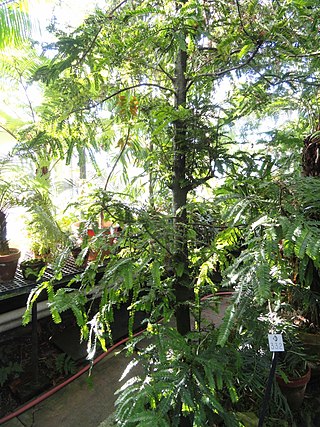
Retrophyllum is a genus of conifers in the family Podocarpaceae. It contains five generally recognized extant species with a disjunct distribution in the Southern Hemisphere, found in Papuasia and also in South America. Retrophyllum are evergreen trees typically occurring in tropical rainforests and cloud forests.
Thuja sutchuenensis, the Sichuan thuja, is a species of Thuja, an evergreen coniferous tree in the cypress family Cupressaceae. It is native to China, where it is an endangered local endemic in Chengkou County, on the southern slope of the Daba Mountains.

Calocedrus decurrens, with the common names incense cedar and California incense cedar, is a species of coniferous tree native to western North America. It is the most widely known species in the genus, and is often simply called incense cedar without the regional qualifier.

Cupressus torulosa, commonly known as the Himalayan cypress or Bhutan cypress, is a species of cypress tree native to the mountainous northern regions of the Indian subcontinent, in the western Himalayas.

Calocedrus formosana is a conifer endemic to Taiwan.

Calocedrus macrolepis, commonly known as Chinese incense-cedar; is a species of conifer native to southwest China, northern Vietnam, northern Laos, extreme northern Thailand and northeastern Myanmar.



